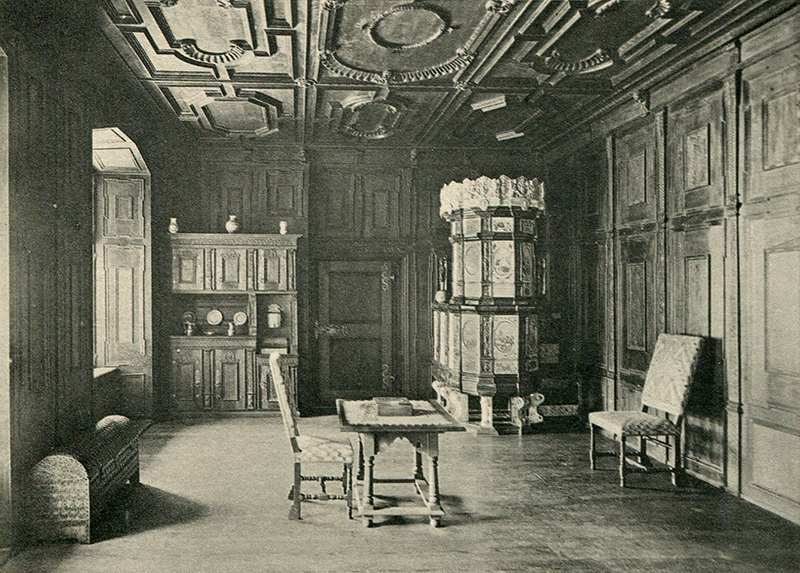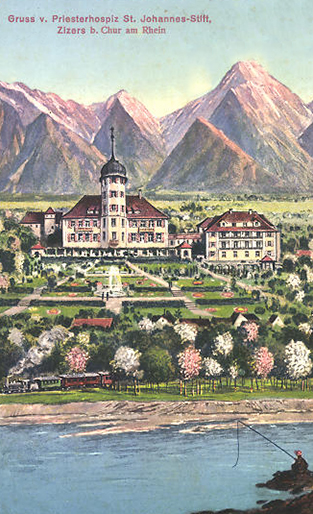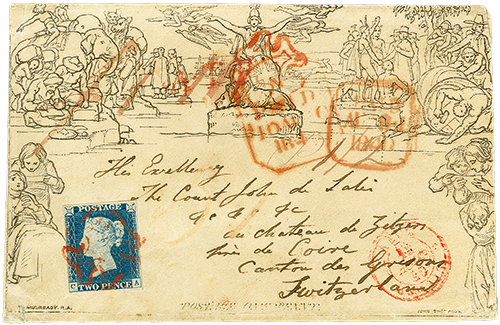180 years ago: the first stamps and prepaid envelopes reach Switzerland!
In the summer of 1840 Johann Heinrich Anton von Salis-Zizers (1805-1858) was probably very surprised when the postman at Zizers handed over the decorative envelope from Tandragee in Ireland to the Lord of the castle in Zizers. What was this unusual pictorial design on the letter? On closer inspection "His Excellency, Count John de Salis, au Chateau de Zitzers, pres de Coire, Canton des Grisons" was able to recognise the artistic representation of the British Empire by William Mulready. Mulready was one of the most popular artists in the United Kingdom in the early years of the 19th century. The central figure was Britannia, who sent her winged messengers by post over land and sea to the British Empire in all directions. In the west to British farmers who had emigrated to America, and in the Far East to India. But why did such a letter come to Switzerland? Additionally, a blue stamp with the head of Queen Victoria was in the left corner. Numerous postmarks and indications of fees showed that the letter had reached its destination at the end of a long journey.

What Johann von Salis-Zizers probably did not suspect at that time was the importance that the letter would have for the history of communications and philately in Switzerland in 2020. Because today the letter is one of two known covers sent to Switzerland in 1840 with an example of the world's first stamp issue and the only surviving Mulready postal stationery envelope sent to Switzerland. A unique item!

The sender in Ireland had paid for the letter to the Lord of Salis-Zizers in advance. For this he used a 2 pence 'fee receipt', which was only available for a few months after the British postal reform of May 1840, and one of the 1 penny prepaid envelopes with the artistic representation of the British Empire by William Mulready. But at the post office in Tandragee the sender discovered that the postage to Switzerland was much higher than the 3 pence prepaid by the stamp and envelope. Another 11 pence was still missing, almost half a day's wages at the time. But there was no room on the letter for many additional stamps without covering over the artistic representation or the address. So he paid the remaining 11 pence in cash at the post office. Thus the letter was paid at least up to the French-Swiss border post office at Hüningen. Further than this, an advance payment was not possible at that time due to the lack of postal agreements between the countries concerned. The Lord of the castle, as the recipient of the letter, therefore had to pay extra for the journey from the French border to Salis-Zizern Castle.
Salis-Zizers Castle was built 330 years ago. It was the seat of the noble Salis-Zizers family, who lived there until the end of the 19th century (Picture above: room in the castle). In 1899, the "St. Johannis-Stift" retirement and nursing home moved into the castle (Picture to the right). In addition, the Bavarian King Ludwig took refuge in the castle with his family and large entourage after the First World War. The most famous inhabitant was probably the last Empress of Austria, Zita of Bourbon-Parma, who spent her old age in the St. Johannis-Stift nursing home.
Look forward to this unique item of Great Britain and Switzerland philately in the next Corinphila auction from 7 to 12 September 2020!
